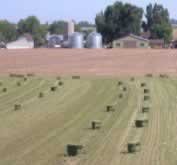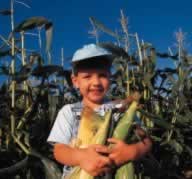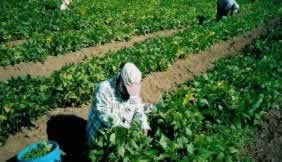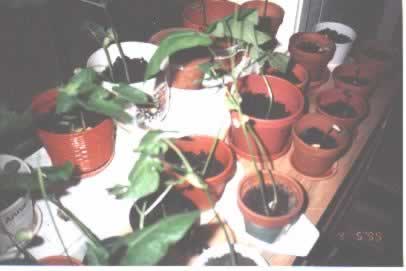Report
to NASA
by BioServe
(located on the campus of the University of Colorado, Boulder, CO)
Report Date: 7/31/98
Mission Report: NASA 6 / Mir Space Station
Subject: Anti-fungal properties of ODC
I. Background
Aeroponics International, formerly EnviroGen, Inc., of Berthoud, Colorado,
has been exploring the elicitation of a plantís own natural defense systems
to fend off fungal pathogen attacks. They place the plant in contact
with a naturally occurring compound that elicits the production of fungal
fighting compounds within the plant. BioServe has been involved
in plant growth experiments in space almost since the Centerís inception
in 1987. Research conducted by BioServe researchers may indicate that
seedlings grown in space develop fewer lignified vascular elements and
less lignin overall (Campbell et al. 1996). Previous research on mung
bean sprouts demonstrated similar results (Cowles et al. 1994). This research
indicates a shift in the plants metabolic pathways. This could be
a result of a number of factors including influences on environmental
parameters induced by the experimental hardware, or potentially part of
the gravitropic sensory and response mechanisms, or, most intriguing,
a decrease in mechanical loading due to the microgravity environment.
Based on these and other initial studies, Aeroponics International is
interested how the hypothesized shift in metabolic pathways would affect
the elicitation of the antifungal response during space flight.
This interest is both to better understand the underlying mechanisms of
the elicitation as well as the applicability of this technology for use
in future advanced life support food production systems for long term
space missions.
II. Objective / Hypothesis
The objective of this experiment was to determine whether or not the antifungal
response of the plants was maintained during spaceflight. Of even greater
interest is whether or not Aeroponic Internationalís elicitor induced
the same response on plants grown in space as it did for plants on the
ground. The hypothesis is that plants grown in space, with and without
the elicitorís influence, will show greater production of antifungal compounds.
III. Results
Along with the experiments that were conducted aboard Mir during NASA
6, concurrent ground control experiments were conducted at SpaceHab in
Cape Canaveral, Florida. Adzuki beans were selected as the test subject
due to slower growth characteristics than Mung beans providing higher
mission success probability in the event of return mission delays. The
experiment included untreated controls as well as the treated experiments
with varying elicitor levels to investigate dose responses of the plants
in the two different gravitational environments. Most of the seedlings
were returned alive to Earth and have undergone biochemical assay to determine
the extent of the elicitation. One set of seedlings was fixed on orbit
and is undergoing further analysis to determine differences in plant structure
and the effect of low gravity on the gravisensing cells (statocytes) of
the treated and control seedlings.
In general the seeds sprouted quite well both on
Earth and onboard Mir. The Mir-grown seedlings tended to exhibit
more growth than those grown on Earth. Though no fungal challenge
was intentionally introduced into the plants, we did see fungal infection
of several of the seedlings. Preliminary visual analysis indicated
that the seedlings that were pretreated with the elicitor exhibited less
fungal infection than the untreated seeds. This was true for both
flight and ground experiments. Biochemical analysis has supported
this finding and has further shown these plants have retained their fungal
fighting abilities and the elicitor has maintained its effectiveness in
microgravity. Further analysis is still being performed on the fixed
samples to determine structural differences in the seedlings.
IV. Conclusions
This experiment suggests that plants can retain their fungal fighting
abilities during growth in microgravity. Further, the elicitation
of antifungal compounds by Aeroponics Internationalís proprietary
elicitor and delivery system exhibits the same dose response both on the
ground and during space flight.
V. Terrestrial applications of the findings
There is tremendous terrestrial application of this technology.
Fungal pathogen infection is a major cause of crop failure around the
world. Widespread use of pesticides raises crop production costs and has
potentially dramatic health concerns. Aeroponics Internationalís
elicitor technology with their unique, patented delivery system can improve
food safety and ground-water quality, as well as reduce farming cost.
This and future studies will help the company perfect
its delivery system for a variety of crops including potatoes, wheat,
barley, tomatoes, rice and soybeans. These experiments are also a potentially
important part of NASAís search for viable strategies to grow food plants
on long term space flights or on future bases on other planets or moons.
VI. Photos
Photos from the Mir Space Station/Kennedy Space Center ODC
Tests
|








